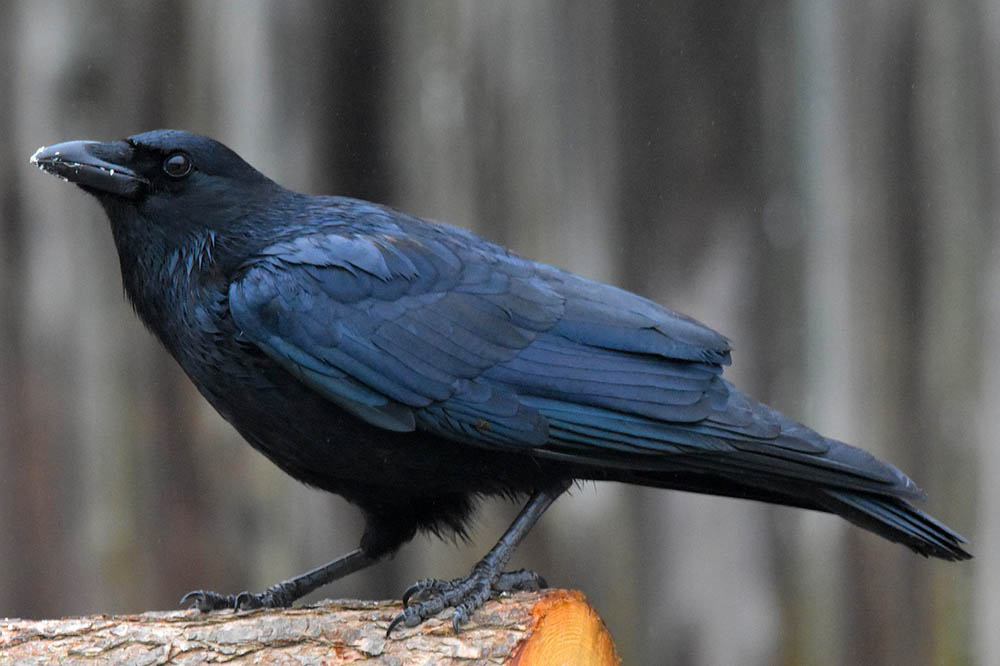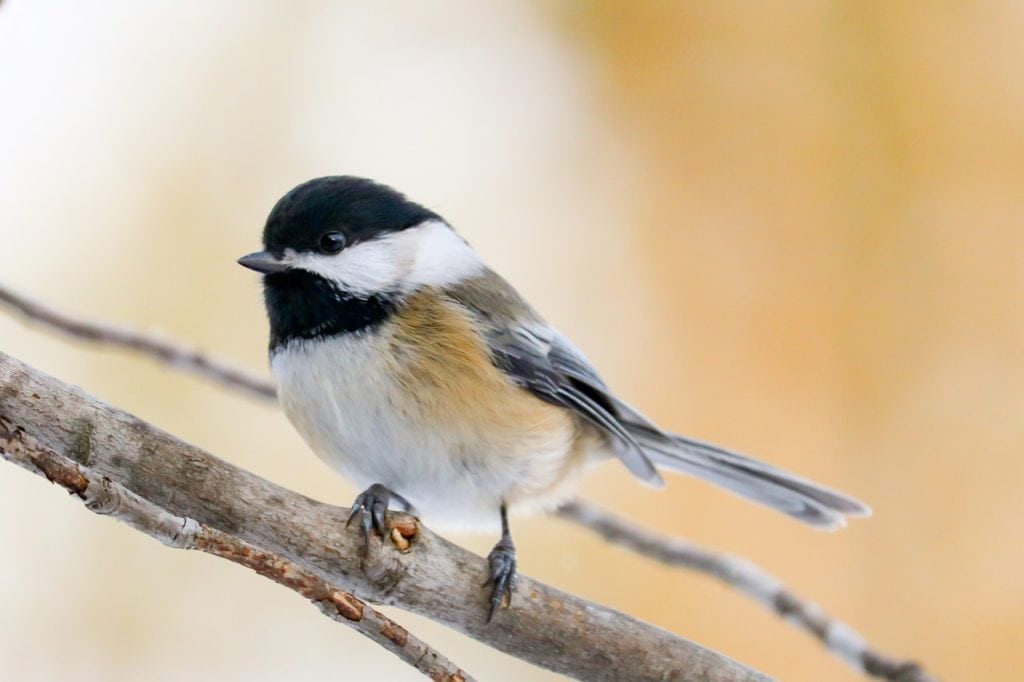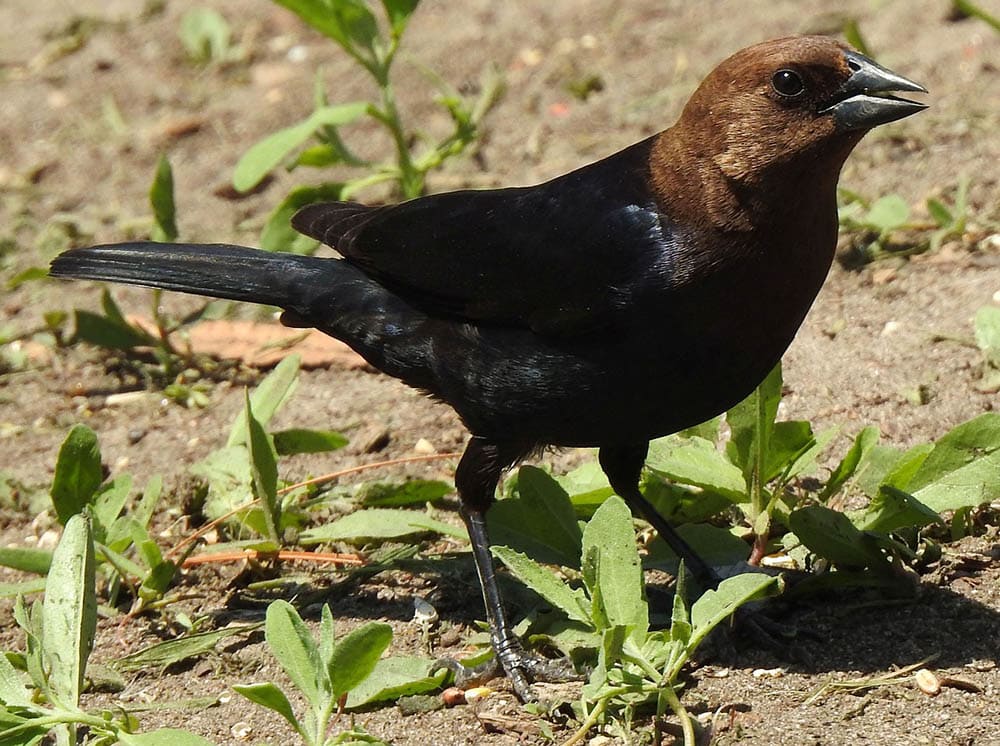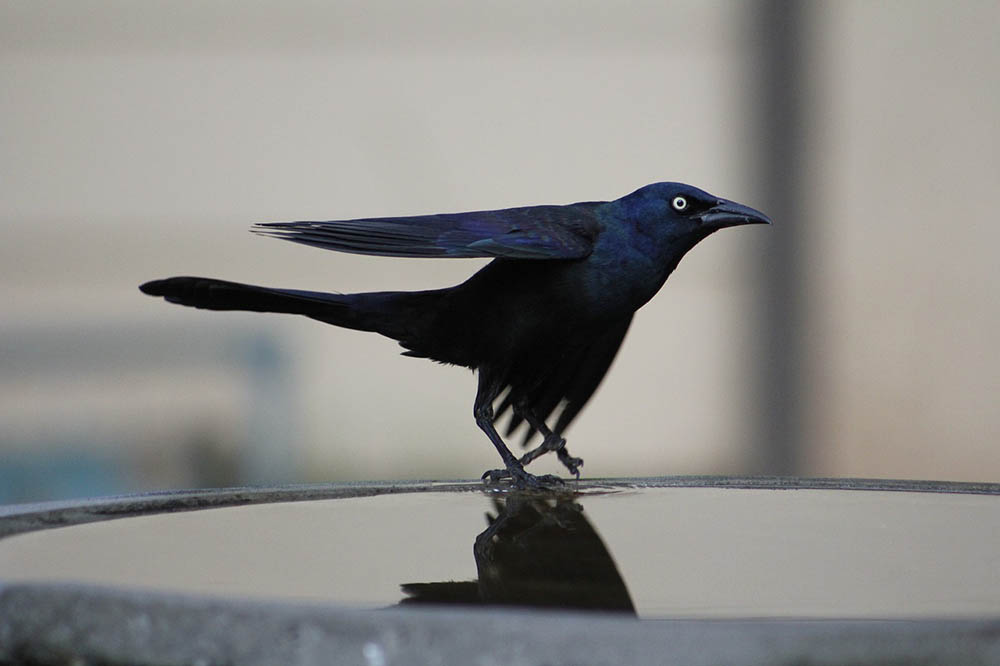25 Common Backyard Birds in Illinois (With Pictures)
Last Updated on

Illinois is home to various species of birds that live in all kinds of different habitats. However, you don’t have to travel far or go to nature parks to find them. Many birds have adapted and become accustomed to living in spaces near humans.
You can find at least 25 different species of birds in your own backyard. All you have to do is pay attention and know what to look for. Here’s our list of common backyard birds that you can find in Illinois.
The 25 Most Common Backyard Birds in Illinois
1. American Crow

| Scientific Name: | Corvus brachyrhynchos |
| Colors: | Black |
| Wingspan: | 33-40 inches |
| Food Preferences: | Insects, seeds, small animals |
The American Crow is a resilient and adaptive bird that can be found all throughout the United States. This bird is a common sight to see in Illinois year-round and is easily identified by its iridescent black feathers.
American Crows have an average lifespan of 8 years in the wild. However, in captivity, they can live up to 30 years. They’re one of the smartest families of birds and can learn to use tools and teach each other how to do new things.
2. American Goldfinch

| Scientific Name: | Spinus tristis |
| Colors: | Yellow, black |
| Wingspan: | 4-5 inches |
| Food Preferences: | Plants, seeds |
American Goldfinches are migratory birds that pass through Illinois and spend summers near the Canada border and winters near Mexico. They’re very noticeable because of their vibrant yellow feathers and are often referred to as “wild canaries.”
These birds are quite social and can travel in large flocks during non-breeding seasons. They have their own social hierarchy and can show aggression to one another to establish dominance, especially during breeding season when they’re looking for mates and nesting spaces.
3. American Robin

| Scientific Name: | Turdus migratorius |
| Colors: | Orange, brown |
| Wingspan: | 12-16 inches |
| Food Preferences: | Worms, fruit |
The American Robin is one of the most common birds you’ll find in Illinois. They’re hardy birds that stay in Illinois year-round and can even withstand harsh winters. You can easily identify these birds by their orange breast and bellies. The male and female American Robin look similar at a quick glance, but the male’s orange feathers are slightly more vibrant than the female’s feathers.
Male American Robins can sing a beautiful tune, and you’re most likely able to hear it during the evening when the sun sets. These birds eat a variety of foods, but they have a particular fondness for sweets, such as fruits and berries. Some American Robins can even become attracted to fermented fruit and start exhibiting intoxicated behaviors after indulging in them.
4. American Tree Sparrow

| Scientific Name: | Spizelloides arborea |
| Colors: | Brown, gray, white |
| Wingspan: | 9-10 inches |
| Food Preferences: | Seeds, insects |
American Tree Sparrows are common brown birds in Illinois. They typically reside in their natural habitats in the tundras of Alaska and Canada, and they migrate further south to the United States for the winter.
These birds aren’t shy and tend to flock toward bird feeders. They also need to eat about 30% of their body weight. So, if you put up a feeder in the colder months, you’ll most likely find some American Tree Sparrows become frequent visitors.
5. Barn Swallow

| Scientific Name: | Hirundo rustica |
| Colors: | Blue, white |
| Wingspan: | 12-14 inches |
| Food Preferences: | Insect |
The Barn Swallow is a beautiful bird with deep blue feathers draping the top of its body and a white underside. These birds got their name because they aren’t too afraid or bothered by humans and can live in close proximity to them, such as in barns.
Many people welcome Barn Swallows because they’re insectivores and can feed on common pests including flies and aphids. They create distinct cup-shaped nests with a mud base, and you can usually find them attached to ceilings and fences. The positioning of their nests can help keep pests outside of homes.
6. Black-Capped Chickadee

| Scientific Name: | Poecile atricapillus |
| Colors: | White, gray, black, tan |
| Wingspan: | 6-8 inches |
| Food Preferences: | Insects, berries, seeds |
Black-Capped Chickadees are nonmigratory Illinois songbirds. You can often find them in forests, but they can also venture into more urban environments.
These birds are known to molt every year at the end of their reproductive season. They’re also monogamous, and males are very involved in parenting chicks. While females are the main caretakers, the males will work tirelessly to forage and hunt for food to feed both their mates and their hatchlings.
7. Blue Jay

| Scientific Name: | Cyanocitta cristata |
| Colors: | Blue, black, white |
| Wingspan: | 13-17 inches |
| Food Preferences: | Seeds, nuts |
Blue Jays have a striking bright blue appearance and are easily spotted when they’re nearby. They mostly live in the eastern and central United States and in some of the southern parts of Canada.
Don’t be fooled by the Blue Jay’s pleasant experience. These birds are known to be aggressive and can even kick out other birds from their nests and decapitate them. They’re also rather loud and vocal. However, their confidence can often get the better of them as they’re rather easy prey for large predatory birds, especially hawks.
8. Brown-Headed Cowbird

| Scientific Name: | Molothrus ater |
| Colors: | Blue, brown, black |
| Wingspan: | 12-15 inches |
| Food Preferences: | Insects, seeds |
These birds are permanent residents in the southern United States, but you can still find flocks of them living in the northern States, including Illinois. Brown-Headed Cowbirds in Illinois are a common sight to see during the summer months, and they often travel in flocks mixed with other species of birds.
Brown-Headed Cowbirds don’t raise their own young, and female birds will lay their eggs in other birds’ nests. Despite being raised by other bird species, Brown-Headed Cowbird hatchlings are still able to detect and respond to vocalizations of their own species. So, they’re able to eventually find a flock of their own species when they’re old enough to leave their nests.
9. Cedar Waxwing

| Scientific Name: | Bombycilla cedrorum |
| Colors: | Brown, gray, yellow, red |
| Wingspan: | 8-12 inches |
| Food Preferences: | Berries, fruit, insects |
Cedar Waxwings are interesting-looking birds with feathers that give off a silky appearance and glossy wingtips that look like they’ve been dipped in wax.
These birds prefer to live in wooded areas near running bodies of water. So, if you’d like to increase your chances of seeing them, you can plant a bird fountain in your yard and plant berry bushes or lay out berries nearby.
Cedar Waxwings tend to travel in large flocks. They’re very social and non-aggressive and can even be seen grooming each other when they’re not in flight.
10. Common Grackle

| Scientific Name: | Quiscalus quiscula |
| Colors: | Blue, black |
| Wingspan: | 8-12 inches |
| Food Preferences: | Insects, berries, fish |
Common Grackles are mostly found east of the Rocky Mountains and some flocks are permanent residents in Illinois. These birds prefer semi-open areas and will nest in thick trees.
One of the most prominent features of this bird is its iridescent appearance. They also have unique bills that can saw through nuts with hard shells, such as acorns.
These birds are known to be brave and scrappy. They’re ready to swoop in and pick up any food dropped by people, and can even snatch food from the mouths of other birds.
11. Dark-Eyed Junco

| Scientific Name: | Junco hyemalis |
| Colors: | Gray, brown, white |
| Wingspan: | 7-10 inches |
| Food Preferences: | Insects, seeds |
Dark-Eyed Juncos are small yet hardy birds. While you can spot them in Illinois in colder months, they can venture up north and reach the Arctic in the summer. Some flocks are permanent residents in the northern States.
You’ll have the best luck finding these birds in coniferous forests, but they’re also not too shy about venturing into small towns. They like to forage close to the ground and search for insects and seeds. A flock of Dark-Eyed Juncos is also known as a blizzard.
12. Eastern Bluebird

| Scientific Name: | Sialia sialis |
| Colors: | Blue, red, brown, white |
| Wingspan: | 9-13 inches |
| Food Preferences: | Insects, fruit |
Easter Bluebirds tend to live in open areas with a smattering of trees. They’re very social and can travel in flocks that surpass a hundred birds. However, they’re also very territorial during the breeding season and will continue to protect their territory during winter months when food is more scarce.
Eastern Bluebirds grew in popularity because of their association with spring. References to them can be found in popular writings and songs, such as “Zip-A-Dee-Doo-Dah.”
13. Eastern Wood-Pewee

| Scientific Name: | Contopus virens |
| Colors: | Gray, white |
| Wingspan: | 9-10 inches |
| Food Preferences: | Insects |
Eastern Wood Pewees are migratory birds that can be found in the eastern half of the United States. They migrate to Central America, the Caribbean, and South America in the colder months. These birds have a very consistent migration pattern that hasn’t had significant variances in the past 100 years.
Male Easter Wood Pewees tend to be aggressive and territorial. They can also be polygamous and mate with two females in one breeding season. Both parents tend to their hatchlings and will continue to feed them until they’re ready to leave the nest and fly.
14. Gray Catbird

| Scientific Name: | Dumetella carolinensis |
| Colors: | Gray |
| Wingspan: | 8-12 inches |
| Food Preferences: | Fruit, insects |
Gray Catbirds are also known as the “Slate-Colored Mockingbird.” They can often be found in thorny thickets, and you can hear them singing from these spots while being hidden from view.
These birds received their name because their natural call sounds very similar to a cat. They’re also really good at mimicking and can easily pick up the songs of other birds. Some birds will even mimic tree frogs croaking. They also have the ability to make two sounds at the same time.
15. House Finch

| Scientific Name: | Haemorhous mexianus |
| Colors: | Brown, gray, red |
| Wingspan: | 8-10 inches |
| Food Preferences: | Grains, berries, seeds |
House Finches are mostly permanent residents in the areas they live in, but some flocks may migrate further south for the winter months. They used to only live in Mexico, but they eventually made their way up north and now they’re a common sight to see in Illinois.
These birds like to make their nests in small cavities, so you can often find them wedged between building cracks. Due to their nesting habits, they’ll especially appreciate small birdhouses in backyards.
16. House Sparrow

| Scientific Name: | Passer domesticus |
| Colors: | Gray, brown, white |
| Wingspan: | 7-10 inches |
| Food Preferences: | Seeds, insects |
The House Sparrow is a resilient and hardy bird that can be found in all sorts of habitats and environments, including urban cities. They’re rather small birds and often become prey for predatory birds and cats.
House Sparrows have adapted to living with and amongst humans and can sometimes be found as pets. They’re also extremely hardy and adaptable. They can live almost anywhere and can even survive off of berries in dryer climates where water is scarce.
17. House Wren

| Scientific Name: | Troglodytes aedon |
| Colors: | Gray, brown, white |
| Wingspan: | 7-10 inches |
| Food Preferences: | Seeds, insects |
The House Wren is a small songbird that sings mostly during nesting season. There are variations of their songs depending on where the bird lives, so you can say that they have regional songs. It’s almost like how different regions have their own accents.
House Wrens naturally live in floodplain forests, but they’re also very adaptable and can live in close proximity to humans. They’re small but scrappy and can even infiltrate other birds’ nests and destroy their eggs.
Since House Wrens can coexist with humans, you can find traces of them in popular culture. For example, a House Wren was a pet of the character, King Friday XIII in Mister Rogers’ Neighborhood.
18. Indigo Bunting

| Scientific Name: | Passerina cyanea |
| Colors: | Blue, black, gray, brown |
| Wingspan: | 7-10 inches |
| Food Preferences: | Seeds, insects |
Male and female Indigo Buntings look very different from each other. Male birds have bright blue feathers with streaks of gray on their wings, while female birds are brown and don’t have any traces of blue. While the male birds can have a striking appearance, they actually molt after the breeding season and will have brown feathers similar to the females during the winter months.
These birds are migratory, and you can occasionally spot them in Illinois during the warmer months. They’ll usually travel between southern Canada and northern South America as the seasons change.
19. Mourning Dove

| Scientific Name: | Zenaida macroura |
| Colors: | Brown, gray |
| Wingspan: | 14-18 inches |
| Food Preferences: | Seeds |
The Mourning Dove, or Turtle Dove, is a very prominent and abundant bird all throughout North America. These birds are also popular gamebirds and are often hunted for sport and meat.
Despite being frequently hunted, these birds thrive, and it’s mostly because they’re very successful breeders. They can have a relatively large clutch of eggs and can raise up to six hatchlings in a year.
These birds got their name from their distinctive cooing call. They also make frequent appearances in Indigenous American literature and contemporary American and Canadian poetry.
20. Northern Cardinal

| Scientific Name: | Cardinalis cardinalis |
| Colors: | Red, black, olive |
| Wingspan: | 10-12 inches |
| Food Preferences: | Seeds, grains, fruit |
Northern Cardinals are iconic red birds in Illinois that have striking crimson feathers and a handsome crest. They can live in climates with cold winters and are year-round birds in Illinois.
These birds naturally live in woodlands and wetlands, but they can also live in close proximity to humans. Their close relationship with humans has led them to become mascots of many sports teams and the state bird of several different states, including Illinois.
Northern Cardinals also used to be kept as pets because of their song and beautiful plumage. However, they received legal protection from the Migratory Bird Treaty Act of 1918, which banned people from selling them as caged pets.
21. Northern Flicker

| Scientific Name: | Colaptes auratus |
| Colors: | Gray, brown, black, red |
| Wingspan: | 17-21 inches |
| Food Preferences: | Insects, fruit, seeds |
The Northern Flicker is a bird that belongs to the woodpecker family and is one of the few species of woodpeckers that are migratory birds. While birds in southern states tend to be permanent residents, Northern Flickers in Illinois will migrate south for the winter.
These birds can be found in open habitats with an ample amount of trees. Both males and females work together to create cavity nests in trees. The coloration of their hatchlings is correlated to food stress and food quality.
22. Red-Bellied Woodpecker

| Scientific Name: | Melanerpes carlinus |
| Colors: | Orange-red, white, black, gray |
| Wingspan: | 15-18 inches |
| Food Preferences: | Insects, seeds |
Red-Bellied Woodpeckers can be found in the eastern half of the United States, and sightings of these birds in Illinois have risen over the years.
You can hear these birds during breeding season when they become more vocal and also frequently drum trees to attract a mate. Birds living in residential areas have also been known to tap on aluminum gutters to create a louder noise.
Red-Bellied Woodpeckers are monogamous and very protective parents. They’re known to fiercely defend their nests and will attack predators rather than fly away.
23. Song Sparrow

| Scientific Name: | Melospiza melodia |
| Colors: | Brown, tan, gray |
| Wingspan: | 7-10 inches |
| Food Preferences: | Insects, seeds |
Song Sparrows received their names from their wide singing range. They can make beautiful and intricate tunes, and male Song Sparrows can create complex songs to establish their territory and attract mates.
The extent of their musical talents was recently studied. A 2022 study by Duke University found that a male Song Sparrow has the ability to memorize a 30-minute playlist and will deliberately shuffle the songs and patterns to woo female birds.
Song Sparrows are migrant birds, and you can find them and listen to their songs in Illinois during the warmer months.
Related Read: 28 Common Backyard Birds in Florida (with Pictures)
24. Tree Swallow

| Scientific Name: | Tachycineta bicolor |
| Colors: | Blue, gray, brown, white |
| Wingspan: | 11-14 inches |
| Food Preferences: |
The Tree Swallow is a beautiful, glossy bird that migrates to Illinois for the summer months. They prefer to live in open and wooded areas by bodies of water.
Tree Swallows are true creatures of habit and prefer to breed in the same spot as previous years. Male Tree Swallows have an interesting breeding habit where they’ll attack a female Tree Swallow. This action is an invitation to court.
After dancing back and forth, an interested female will inspect a male’s nesting area. If she approves, they will mate. Most Tree Swallows are monogamous, but some males may choose to be polygamous.
25. White-Breasted Nuthatch

| Scientific Name: | Sitta carolinensis |
| Colors: | Blue, gray, brown, white |
| Wingspan: | 8-11 inches |
| Food Preferences: | Insects, seeds |
The White-Breasted Nuthatch is a relatively noisy bird, so once you’re able to distinguish its call, you’ll be able to find them right away. These birds prefer to live in woodlands, but they can be found in various types of habitats and environments in Illinois.
White-Breasted Nuthatches are social and can often be found in multi-species flocks. While they prefer traveling in large flocks, White-Breasted Nuthatches are monogamous. Males will woo females by bowing to females and spreading their tail feathers while swaying around. They’ll also feed her some food during the courtship ritual.

In Conclusion
Now you know that there are at least 25 different kinds of birds that you can find in Illinois. So, install a few bird feeders in your backyard and pull out a set of binoculars. You can get a good bird watching session in without ever having to leave your own home.
Featured Image Credit: Oldiefan, Pixabay
Table of Contents
- The 25 Most Common Backyard Birds in Illinois
- 1. American Crow
- 2. American Goldfinch
- 3. American Robin
- 4. American Tree Sparrow
- 5. Barn Swallow
- 6. Black-Capped Chickadee
- 7. Blue Jay
- 8. Brown-Headed Cowbird
- 9. Cedar Waxwing
- 10. Common Grackle
- 11. Dark-Eyed Junco
- 12. Eastern Bluebird
- 13. Eastern Wood-Pewee
- 14. Gray Catbird
- 15. House Finch
- 16. House Sparrow
- 17. House Wren
- 18. Indigo Bunting
- 19. Mourning Dove
- 20. Northern Cardinal
- 21. Northern Flicker
- 22. Red-Bellied Woodpecker
- 23. Song Sparrow
- 24. Tree Swallow
- 25. White-Breasted Nuthatch
- In Conclusion
About the Author Jessica Kim
Jessica is a freelance writer who spends most of her day researching and writing a number of topics. She loves sharing helpful information that people can use to better understand their pets, nature and the world around them. When she isn't writing, you may find her walking dogs, tending to her plant babies, or drinking her nth cup of coffee.
Related Articles:
Monocular vs Telescope: Differences Explained (With Pictures)
10 Types of Hummingbirds in Arkansas (With Pictures)
8 Types of Hummingbirds in Nebraska (With Pictures)
5 Types of Hummingbirds in Idaho (With Pictures)
3 Types of Hummingbirds in Mississippi (With Pictures)
8 Types of Hummingbirds in Kansas (With Pictures)
5 Types of Hummingbirds in West Virginia (With Pictures)
5 Types of Hummingbirds in Ohio (With Pictures)
